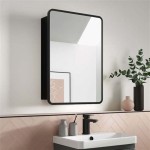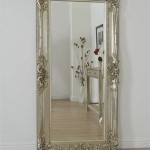Standard Vanity Mirror Dimensions
Vanity mirrors are essential components of bathrooms and dressing areas, providing functionality and enhancing the overall aesthetic. Understanding the standard dimensions of these mirrors can significantly aid in selecting the appropriate size for a given space and ensuring optimal usability.
While there isn't a single, universally prescribed "standard" size for vanity mirrors, certain dimensions are frequently encountered due to their practicality and compatibility with common vanity sizes. These dimensions are often dictated by factors such as bathroom counter widths, user height, and desired viewing area.
A common width for vanity mirrors ranges from 24 inches to 48 inches. This range accommodates single-sink vanities as well as larger double-sink configurations. Mirrors exceeding 48 inches are typically reserved for expansive bathrooms or custom installations.
The height of a vanity mirror is another critical consideration. Standard heights typically fall between 30 inches and 36 inches. This range allows for comfortable viewing for individuals of average height while also considering the typical height of bathroom vanities. Mirrors taller than 36 inches might be suitable for taller individuals or for spaces with higher ceilings.
The relationship between mirror size and vanity size is crucial for a balanced and visually appealing aesthetic. As a general guideline, the mirror should be slightly narrower than the vanity itself. For example, a 36-inch wide vanity might be paired with a 30-inch or 32-inch wide mirror. This creates a sense of proportion and prevents the mirror from overpowering the vanity.
Beyond the overall dimensions, other factors contribute to the perceived size and functionality of a vanity mirror. The frame, if present, can add to the overall width and height. Frame styles vary significantly, from thin, minimalist frames to more ornate and wider designs. The frame style should complement the overall bathroom design.
Another factor influencing the effective size of a vanity mirror is its shape. While rectangular mirrors are the most common, other shapes such as round, oval, and square are also available. These alternative shapes can introduce a unique design element and can be particularly effective in smaller bathrooms or powder rooms.
The mounting style of the vanity mirror also impacts its placement and usability. Wall-mounted mirrors are the most common and offer flexibility in terms of height adjustment. Surface-mounted mirrors, attached directly to the wall, offer a sleek, modern look. Recessed mirrors, integrated into the wall itself, maximize space and create a seamless appearance.
When selecting a vanity mirror, considering the lighting in the bathroom is essential. Adequate lighting around the mirror is crucial for tasks such as applying makeup or shaving. Wall-mounted sconces flanking the mirror or overhead lighting can provide effective illumination. Some vanity mirrors also incorporate integrated lighting, offering a convenient and space-saving solution.
The thickness of the mirror itself is typically not a significant factor in terms of overall dimensions, but it can contribute to the mirror's weight and durability. Standard mirror thicknesses typically range from 1/4 inch to 1/2 inch. Thicker mirrors are generally more resistant to breakage and warping.
In addition to standard-sized vanity mirrors, custom-sized options are available for unique bathroom configurations or design preferences. Custom mirrors can be fabricated to specific dimensions and shapes, allowing for greater flexibility in achieving the desired aesthetic and functionality.
The placement of the vanity mirror relative to the vanity and other bathroom fixtures is also an important consideration. The bottom edge of the mirror should be positioned several inches above the backsplash of the vanity to avoid interference and to provide adequate viewing space.
Choosing the right vanity mirror involves careful consideration of various factors, including the overall bathroom dimensions, vanity size, user height, and desired aesthetic. While standard dimensions provide a helpful starting point, understanding the interplay of these factors is crucial for selecting a mirror that complements the bathroom design and provides optimal functionality.
Careful planning and consideration of these factors will ensure a successful selection, resulting in a vanity mirror that enhances both the functionality and aesthetic of the bathroom space.

Ello Allo 30 In W X 36 H Rectangular Aluminum Framed Wall Mount Bathroom Vanity Mirror Black Evm S F B30 The Home Depot

Better Bevel 20 In W X 28 H Frameless Rectangular Beveled Edge Bathroom Vanity Mirror 17106 The Home Depot

Standard Bathroom Vanity Mirror Height Google Search Sizes Measurements Plan

Bathroom Mirror Size Calculator

Bathroom Vanities Buy Vanity Furniture Cabinets Rgm Distribution

Mirrored Cabinets And Mirrors Guide Kohler

Rectangular Bathroom Mirrors Bevelled Designer Wall Mounted Aica Bathrooms

Standard Height For Bathroom Mirror Dimensions Vanity Sizes Vessel Sink

Fresca Allier 24 Gray Oak Modern Bathroom Vanity W Mirror Luxe Vanities

Becker 710mm Stainless Steel Bathroom Vanity With Mirror








